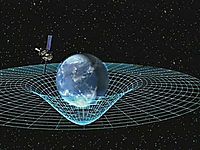
Photo from wikipedia
Research on continuum parallel robots has been essentially devoted to the computation of their geometricostatic models and of their performance in terms of workspace size, accuracy, compliance, force transmission, and… Click to show full abstract
Research on continuum parallel robots has been essentially devoted to the computation of their geometricostatic models and of their performance in terms of workspace size, accuracy, compliance, force transmission, and manipulability. Their singularity analysis has been limited to the identification of a limited number of singular configurations, without any deep investigation of the physical phenomena occurring in these singularities. In this article, we define the singularity conditions for continuum parallel robots. We provide a straightforward interpretation of the phenomena occurring in singularities. Especially, we prove that some singularities appear when the robot potential energy has a local isovalue. Because of this property, we show that these singularities separate the stable configurations from the unstable ones in the workspace. Moreover, on such singularities, the robot can freely move along a given direction without any constraint under the action of small perturbations. We illustrate the singularity phenomena and their effects by simulations performed with two different continuum parallel robots.
Journal Title: IEEE Transactions on Robotics
Year Published: 2022
Link to full text (if available)
Share on Social Media: Sign Up to like & get
recommendations!